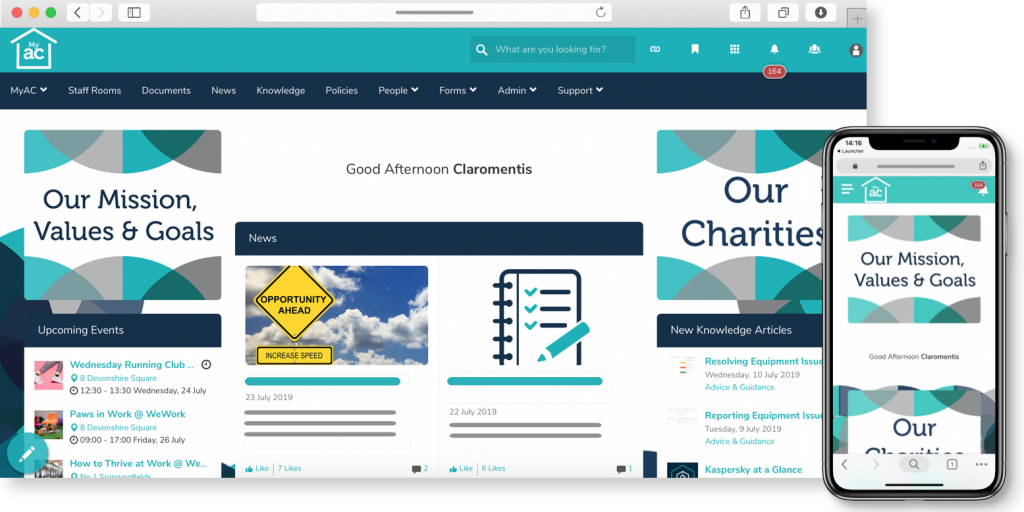Note: this blog was last updated on 7th March 2024
Hybrid and remote working is on the rise worldwide.
In fact, estimates suggest that there will be 92 million remote employees across the world by 2030.
So, if you want to thrive in the digital workplace era, you need the right employee engagement platform.
What are the benefits of an employee engagement platform?
Many businesses are seeing the benefits of a hybrid and remote working world.
After all, they can attract the best talent from across the globe through flexible working and attractive benefits packages. All of which increases productivity, collaboration and engagement.
Flexible working also has a significant business benefit, with research suggesting that it can lead to 21% revenue growth. This is 16% more growth than companies with return-to-office mandates.
But, to gain these benefits you need technology to support you. That’s where an employee engagement platform comes in.
With the right software you will be able to:
1. Improve team performance, communication and collaboration
Companies with engaged employees are 18% more productive and 23% more profitable than those with low engagement.
With the right platform you can track engaged employee performance, seeing how they communicate, collaborate and perform in real-time, in a centralised location. You can also promote knowledge sharing, helping colleagues learn from each other.
What’s more, you can ensure there is a single source of truth on team goals, progress and responsibilities. Reducing confusion and time wasting across your business.
2. Increase employee retention with meaningful engagement
Engaged employees are 3 x more likely to stay with their company long term. So focusing on embedding a company culture of wellbeing and belonging is vital.
Software allows you to monitor employee sentiment, as well as burnout and engagement levels in a meaningful way.
Also, you can provide a two-way communication and feedback loop between employees and leadership. Letting them voice concerns, receive support and feel like they are a vital part of your business. All of which means you can keep good people longer.
3. Use data to make better business decisions
Being data driven makes your business 58% more likely to exceed revenue goals.
With comprehensive dashboards, employee engagement tools can help you make better decisions and become more profitable.
Not only that, engaged workers are more invested in your success. If you want to grow your business, gather their feedback, insights and ideas.
3 steps to choosing the right platform for your business
1. Conduct a requirements analysis
As with any investment, getting a good return on your employee engagement platform relies on understanding what your goals are.
If you’re not sure, conduct a requirements analysis before researching your options.
To do so, you’ll need to survey the likely stakeholders and users of your platform. This will help you find out what works well currently, what doesn’t and what improvements they would like to see.
Stakeholder identification is simple – if they are going to use the platform, their opinion matters. So, if practical, speak with them.
If you are in a larger organisation it’s likely you won’t be able to speak with all stakeholders. That’s okay, just make sure you talk to people representing:
-
Desk-based employees
-
Frontline employees
-
Remote employees
-
Every seniority level within your business
-
All available demographics within your workforce
Questions to ask during your requirement analysis
Once you have identified your key stakeholders, you need to find answers to these 20 questions:
- Why do we want to implement an employee engagement platform?
- How will this platform align with our overall business strategy and values?
- What outcomes or KPIs do we want to achieve with this platform?
- What features and functions do stakeholders expect from the platform?
- What employee engagement gaps or challenges will we address with this platform?
- What types of content will we prioritise and use on the platform?
- What accessibility requirements do we need to ensure inclusivity for all employees?
- How important is mobile access?
- What functions and features need to be available on mobile devices?
- What languages should the platform support to cater to all employees?
- How should the platform integrate with existing tools or systems? Are we replacing or integrating with legacy software?
- What data privacy and security requirements do we have?
- How will the platform collect, use and protect employee data?
- What are the potential barriers to adoption, and how do we mitigate them?
- Will we need training and support for users?
- How will we measure employee engagement ROI with the platform?
- How will we collect feedback on the platform? And what process will we use to action feedback on the platform?
- How adaptable does it have to be to meet evolving business needs?
- What is our budget for implementation and maintenance of the platform?
- What internal resources do we need to launch and maintain the platform?
2. Make a list of priorities
Once you have spoken with everyone, collate the information into an actionable requirements analysis. For example, you may find that:
-
Remote workers feel isolated and struggle to collaborate with office-based teams
-
Employees have issues accessing expertise housed in different departments
-
Employees resent how long it takes for annual leave to be approved
Identify common themes and prioritise based on their importance to both your employees and your business. This means you can improve employee retention and satisfaction while achieving your business goals.
When researching the best employee engagement platform, map these priorities directly to the features on offer.
For example, knowledge transfer issues due to information silos can be solved using discussion rooms, instant messaging and other intranet communication and collaboration tools.
Or perhaps security is your focus, meaning you need single sign on capabilities on a secure, compliant platform?
Find the perfect platform for you by rating it against your needs. No matter how complex, you will find a software that can do everything you need. It’s just a matter of time and research.
Here are a few resources and ideas to help you find the right software:
-
Read software reviews on sites such as G2, Capterra, and Software Advice.
-
Consume vendor content such as blogs, videos demos and walkthroughs.
-
Try out free trials and freemium software.
-
Ask your own professional network to see what software they recommend.
3. Research vendors and invite them to demo
Once you have identified a few platforms that meet your needs. It’s time to try them out.
Invite your shortlist to provide a demo of their engagement platform.
Ideally, this would be a personalised demo that speaks to your specific needs. This will give you a good indication of whether or not the software is for you.
If you’re not sure how to rate the software during the demo, look out for the below:
- Ease of use. Could anyone at your business use it? Or would you need technical IT support every time you wanted to make a change?
- Customisation capabilities. An employee engagement platform should feel like home. Can you customise it to individual needs? Can you align the platform with your brand identity, mission, vision and values?
- Integrations. How easily can you integrate existing legacy software and systems into their software?
- Analytics and reporting. Does the software provide simple dashboards that help you prove ROI and value to leadership?
- Feedback mechanisms. Can employees engage in two-way communication about the business with c-suite?
- Communication tools. Would the toolset simplify and streamline your communications? Or would it just be another channel employees ignore?
- Support and training. How willing are the vendors to help you get up to speed? Do they provide training and ongoing support?
Questions to ask during your demo
Here are 10 useful questions that will help you make the most of your demo session:
- Can you run through a specific, real-world scenario that shows me [desired outcome/feature]?
- Can you show how the platform integrates with our existing toolset?
- How customisable is the platform? Can it adapt to my brand and specific employee engagement strategies?
- What employee engagement analytics and reporting are available?
- How does the platform enable employee recognition and rewards?
- How would we gather employee feedback? Are there mechanisms in place to ensure anonymity?
- How can the platform support initiatives for wellbeing, culture and belonging?
- What security measures are in place to protect our sensitive data?
- Do you offer training and support services during and after implementation?
- What is the pricing model? How does it scale and does it include everything?
Boost employee engagement in 2024 and beyond
For internal comms teams, employee engagement is the number one measure of success. Yet, the majority of teams have neither the time nor resources to really make an impact.
We’ve talked about how you can find the perfect software to help you. But what about the rest?
Software is a tool. To really improve your employee engagement initiatives and demonstrate ROI to leadership, you need a strategy.
That’s where we can help.
Click below to download our latest guide on how to create a world beating internal communications strategy.
It’s full of actionable recommendations on how to enhance employee engagement and collaboration, increase productivity and create a company culture that you can be proud of. All in an environment where teams are expected to do more with less.



